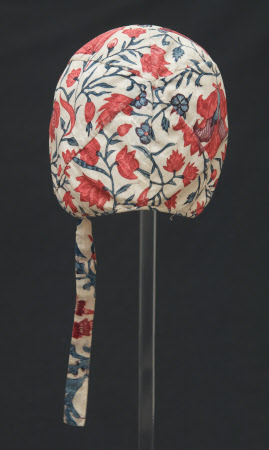Cap
Category
Costume
Date
1780 - 1800
Materials
Cotton chintz and linen
Order this imageCollection
Snowshill Wade Costume Collection, Gloucestershire
NT 1350487
Summary
Cap for a baby or young child made from Indian chintz featuring a design of meandering flowering branches painted and printed in red, blue and purple onto a white cotton ground. It has a lining of bleached linen and is close fitting with 6 gores round over the ears and the edge is self bound.
Full description
This small cap is made of Indian chintz, with red, blue and purple painted and printed meandering flower branches on a white ground. Indian cotton textiles revolutionised European clothing in the 17th and 18th centuries. Decorative, easily laundered and inexpensive, cotton fabrics made fashionable consumption a possibility for the middle classes. They were popularly known as chintz, derived from the Hindi chint or chitta, meaning spotted or variegated. Indian textile-makers block printed and hand painted vibrant floral patterns using indigo and madder dyes onto woven cotton. Chintz was exported by British merchants like those of the East India Company and quickly prompted European imitations. Indian chintz was so popular with 18th-century consumers that imports were prohibited by the Calico Acts, legislation intended to protect British textile industries. Although chintz remained in wide circulation, brought home by textile merchants and travellers, European efforts to manufacture block-printed cotton eventually resulted in British dominance of the global cotton trade, reversing established trading patterns by exporting Lancashire cottons to India. Emma Slocombe
Provenance
Charles Paget Wade Collection, Snowshill Manor
Exhibition history
Cotton: Global Threads, Whitworth Art Gallery, Manchester , 2012
